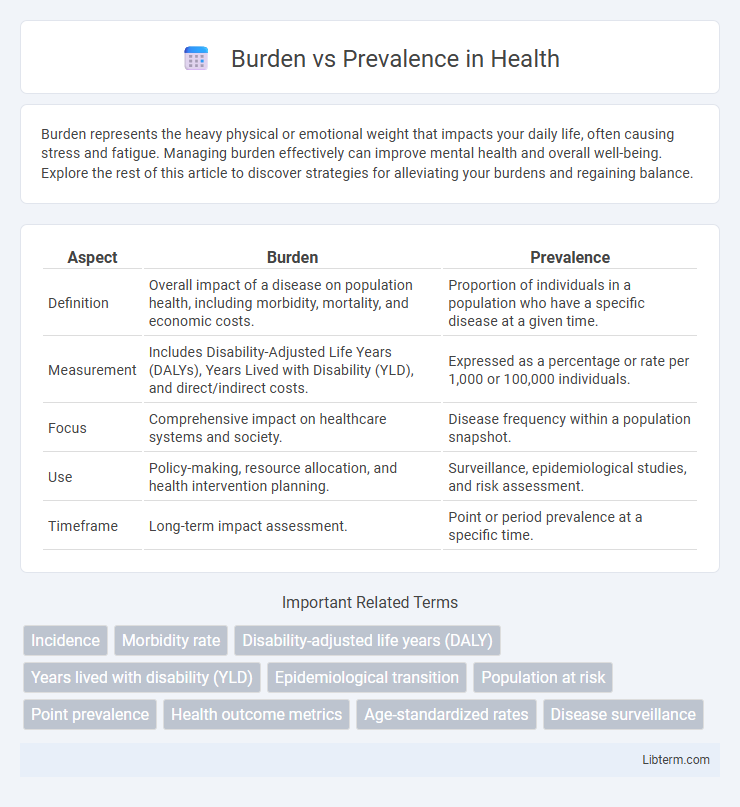Burden represents the heavy physical or emotional weight that impacts your daily life, often causing stress and fatigue. Managing burden effectively can improve mental health and overall well-being. Explore the rest of this article to discover strategies for alleviating your burdens and regaining balance.
Table of Comparison
| Aspect | Burden | Prevalence |
|---|---|---|
| Definition | Overall impact of a disease on population health, including morbidity, mortality, and economic costs. | Proportion of individuals in a population who have a specific disease at a given time. |
| Measurement | Includes Disability-Adjusted Life Years (DALYs), Years Lived with Disability (YLD), and direct/indirect costs. | Expressed as a percentage or rate per 1,000 or 100,000 individuals. |
| Focus | Comprehensive impact on healthcare systems and society. | Disease frequency within a population snapshot. |
| Use | Policy-making, resource allocation, and health intervention planning. | Surveillance, epidemiological studies, and risk assessment. |
| Timeframe | Long-term impact assessment. | Point or period prevalence at a specific time. |
Understanding the Concepts: Burden vs Prevalence
Burden refers to the overall impact of a disease on a population, encompassing morbidity, mortality, and economic costs, while prevalence measures the total number of existing cases of a disease at a specific point in time. Understanding the burden provides insight into healthcare resource allocation and prioritization, whereas prevalence helps identify the scale and distribution of a condition within a population. Distinguishing these concepts is critical for effective public health planning and disease management strategies.
Defining Disease Prevalence
Disease prevalence measures the total number of existing cases of a specific illness within a population at a given time, providing insight into the extent of health conditions across demographics. This metric is critical for understanding the burden of disease, as it reflects both new and chronic cases contributing to healthcare demands and resource allocation. Prevalence rates influence public health strategies by identifying populations at higher risk and highlighting the ongoing impact of diseases on communities.
What Constitutes Disease Burden?
Disease burden encompasses the overall impact of a health problem on a population, measured through metrics such as Disability-Adjusted Life Years (DALYs), Years of Life Lost (YLL), and Years Lived with Disability (YLD). It reflects not only the prevalence of a disease, which indicates how widespread the condition is at a given time, but also the intensity of its effects on quality of life and mortality rates. Understanding disease burden requires analyzing both the prevalence and the severity of conditions to inform healthcare priorities and resource allocation.
Key Differences Between Burden and Prevalence
Burden measures the overall impact of a health condition on a population, including economic, social, and healthcare costs, while prevalence quantifies the total number of existing cases of a disease at a specific point or period. Burden encompasses metrics like Disability-Adjusted Life Years (DALYs) and Quality-Adjusted Life Years (QALYs), providing insight into disease severity and population health loss, whereas prevalence simply indicates disease frequency. Understanding these distinctions aids in public health planning by differentiating between the scale of a health problem and its widespread occurrence.
Measuring Prevalence: Methods and Importance
Measuring prevalence involves quantifying the total number of cases of a disease or condition within a specific population at a given time, employing methods such as cross-sectional surveys, population registries, and medical records analysis. Accurate prevalence data is crucial for resource allocation, healthcare planning, and evaluating public health interventions. Epidemiologists rely on standardized definitions and sampling techniques to ensure reliable and comparable prevalence estimates across different regions and populations.
Assessing Disease Burden: Tools and Indicators
Disease burden assessment utilizes tools such as Disability-Adjusted Life Years (DALYs), Quality-Adjusted Life Years (QALYs), and Years Lived with Disability (YLDs) to quantify the impact of health conditions beyond mere prevalence rates. Prevalence measures indicate the total number of cases at a given time, whereas burden metrics capture both morbidity and mortality, reflecting the comprehensive health loss. Effective disease burden evaluation informs resource allocation by integrating epidemiological data with indicators like incidence, mortality rates, and healthcare utilization.
Factors Influencing Prevalence Rates
Prevalence rates of diseases are influenced by factors such as population demographics, environmental exposures, and access to healthcare services. Socioeconomic status and genetic predispositions also play critical roles in determining how widespread a condition may be within a community. Variability in diagnostic criteria and reporting practices can further impact the accuracy of prevalence data.
Determinants of Disease Burden in Populations
Disease burden in populations is primarily influenced by determinants such as socioeconomic status, environmental exposures, and healthcare accessibility, which shape the prevalence and impact of illnesses. Variations in genetic predisposition, lifestyle factors, and public health interventions further modulate the distribution and intensity of disease burden across different demographic groups. Understanding these determinants aids in targeting resources effectively to reduce both the prevalence and overall burden of diseases.
Implications for Public Health Policy
The burden of disease, encompassing mortality, morbidity, and economic costs, directly informs public health policy by highlighting the need for targeted interventions and resource allocation. Prevalence data, indicating the proportion of individuals affected by a condition at a given time, guides surveillance efforts and prioritizes screening programs. Understanding the interplay between burden and prevalence enables policymakers to implement effective prevention strategies, optimize healthcare delivery, and improve population health outcomes.
Integrating Burden and Prevalence for Effective Interventions
Integrating burden and prevalence data enables healthcare planners to allocate resources more efficiently by identifying high-impact diseases with widespread occurrence. Accurate prevalence rates combined with burden measures such as DALYs and QALYs guide targeted interventions that reduce both incidence and severity of conditions. This approach improves health outcomes by prioritizing diseases that impose the greatest collective strain on populations and healthcare systems.
Burden Infographic

 libterm.com
libterm.com